|
FAMILIES REUNITED
Stuart Campbell comes
from a long and extremely complicated line of ancestors who
contributed their diverse genes to create and shape the unique
individual that we all know and love so much today. But he’s not the
only one.
It’s easy to get irritable
when idiot videogame journalists excitably acclaim the stunning
"originality" of games which have supposedly appeared out of
nowhere, but about which anyone who knows anything about games knows
otherwise. The most celebrated - if that's the right word - example
of recent years would probably be Worms, recipient of all sorts of
originality awards despite being simply the latest in a 20-year-old
line encompassing scores of previous games which play in exactly the
same way.
(The first example your correspondent knows of is Artillery Duel on
the Colecovision from 1983, but the genre may well go back further
still.)
But sometimes that ire is a tad unwarranted, because some games are
so obscure that it's only by sheer dumb luck that anyone would even
have heard of them, far less be able to identify that they were the
estranged parent or illegitimate child of a far better-known
classic. Count on the dauntlessly diligent descendant-detectives of
Retro Gamer, then, to uncover some of the missing links and finally
gather together some of gaming’s greats and their grand-relatives.
------------------------------------------------------------------------------------------------------------
CASE FILE #1 – CHUCKIE EGG
Chuckie Egg is one of retrogaming’s
cornerstones. Alongside the Donkey Kongs, Manic Miners. Stunt Car
Racers and Speedball 2s, Nigel Alderton’s high-speed henhouse
hurry-scurry still represents many people’s ideal for the form, with
its slick controls and non-stop action. Surprisingly few games,
though, have actually replicated its style – not even its own sequel
played similarly, being a comparatively staid and sprawling arcade
adventure. The only game that can truly lay claim to Chuckie Egg’s
DNA is Bill & Ted’s Excellent Gameboy Adventure.
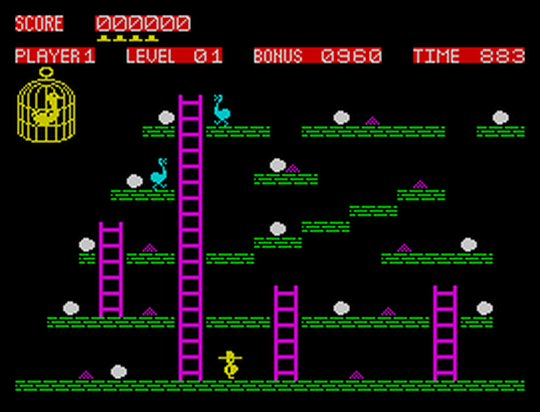
Along with Lode Runner,
Chuckie Egg is a contender for the game to have appeared on the most
formats ever.
Despite this reporter’s single-handed trumpet-blowing crusade over
the last decade, the number of people who’ve heard of this early
platformer for the mono Game Boy is still, taken as an average and
rounded off to the nearest whole number, zero. Which is a tragedy,
because it’s simply one of the greatest platform games of all time.
Comprising 50 single-screen levels spread across 10 worlds, it’s a
riot of invention and pace with something new on almost every stage,
but telltale signs like its speed, ladder-jumping and infinite-fall
ability mark it out as a clear homage to Alderton’s game, with one
of the most obvious tributes being the appearance in World 5 of a
version of Chuckie Egg’s “super duck” (in the form of a flying
stingray) which tracks the player across the level regardless of the
platform structures.
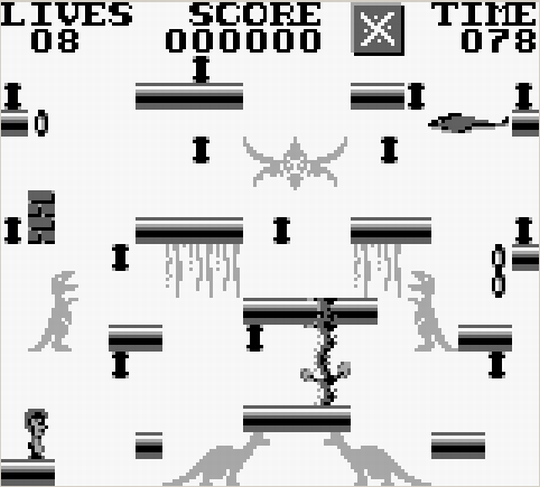
They could quite reasonably
have called this game “Bill And Ted’s EGGS-cellent Adventure”!!!
(Get out – Ed)
Bill & Ted’s EGA takes Chuckie Egg’s ball and runs like the wind
with it, leaving the tiny world of the farmyard behind for the
boundless entirety of time and space, and the gameplay horizons
broaden accordingly. While it never breaks from the basic
run-and-jump-and-collect-stuff template, you never know quite what’s
going to happen on each new level – you’ll be chased through
paradise by relentless angels and teleporting monks, stages will
turn invisible, walls and floors and keys appear and disappear,
enemies pick you up and drop you off the edges of platforms, some
throw boulders or grenades, rabbits roll deadly Easter eggs, other
enemies shoot you with guns or with time-shift bolts that send you
back to the level’s start position, and that’s not the half of it.
Just like Chuckie Egg, some levels are edgy sniping battles where
you pick off a key here and a key there while some are flat-out
headlong sprints, but none will take you more than 30 seconds to
play through once you master them.
But in fact, Bill & Ted’s Excellent Gameboy Adventure is more than
just a de facto Chuckie Egg sequel - it also provides the
missing link between one of gaming’s oldest standards and one of its
newest pioneers. Because with its constant change, instant
accessibility, breathless pace and endless invention and
unpredictability, you only need to continue the logical line from
Chuckie Egg through Bill & Ted and keep going a bit until you
eventually arrive at Wario Ware.
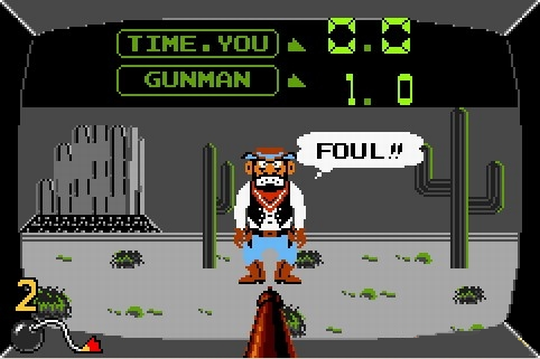
And obviously this guy
should actually be shouting “FOWL”!!!!! (Really,
I’ll have you killed – Ed)
Squished into a tiny 128K cart, Bill & Ted’s had to be endlessly
creative with a very small number of elements. But take away that
restriction – Wario Ware had a whopping 64 times as much RAM to play
around with – and you can refine those levels down from 20 seconds
and 10 seconds to five and three and one, twisting and bending and
distorting them into crazy shapes while sticking to the same
d-pad-and-single-button controls that made Chuckie Egg so instantly
appealing. And you “hen’t” say fairer than that! (That’s it. Get
my gun – Ed)
|
GRAND THEFT
OTOBOKE
You all
know about how Rockstar famously revealed in a magazine
that the Grand Theft Auto games (originally meant to be
more tellingly called Race’n’Chase) were fundamentally
derived from Pac-Man, don’t you? With the obvious
parallels between the overhead-viewed cities of the
original 2D games and Namco’s maze-running classic?
(Interestingly, you were also originally supposed to be
able to choose to play as the police, making the
original GTA the parent in turn of Pac-Man VS - see, the
DNA always makes its way through in the end.)
You do? Splendid. That’ll save us a lot of time later
on.
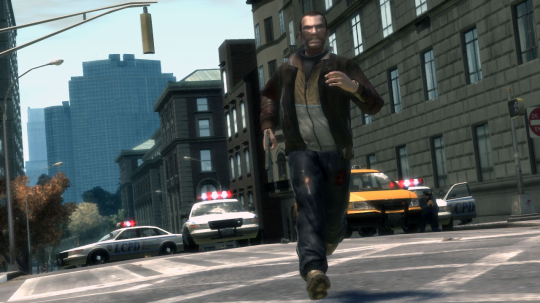
“Goddammit,
there’s gotta be a power-pill around here somewhere!”
|
CASE FILE #2 – THE TRAIN GAME
Beyond any rational doubt,
Sega’s The Typing Of The Dead is the funniest videogame ever made.
It's based on Sega's classic arcade light-gun shooter The House Of
The Dead 2, a game which - while cheesy - is also tense, atmospheric
and in parts really quite scary. But by the simple expedient of
replacing your gun with a keyboard and some random words, it
suddenly becomes impossible to be disturbed by even the goriest
assaults, or to react with anything other than a warm chuckle as a
gruesome monster from under the sea jams a trident between your ribs
when you fail to sufficiently quickly type "MAKE ME A HUMBLE
APOLOGY" or "TELL ME A FUNNY STORY" at it to deflect its savage
attack.
But this feature isn't here to talk about how great The Typing Of
The Dead is (which is to say, amazingly great), but rather to
identify its videogaming parentage. And unlikely as it seems, the
only game (other than House Of The Dead 2, obviously) to which TTOTD
owes a genetic debt is a long-forgotten title from the early days of
the Spectrum about points management and maintaining customer
satisfaction on a railway network.
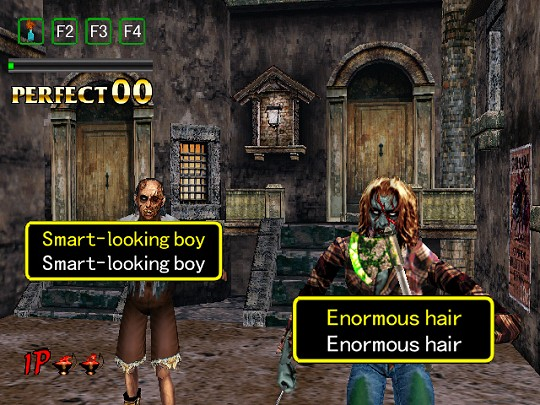
The words
you have to type aren't usually descriptive. We just got lucky here.
Microsphere's 1983 classic
The Train Game wasn't a smash hit even when it only had about 50
other Speccy games in the whole world to contend with. In an age of
the exciting new opportunities offered by the Speccy's
high-resolution colour graphics, the barely-beyond-ASCII visuals
didn't seize gamers' attention, and even those of us still mired in
more medieval times, playing our games on black-and-white bedroom
tellies, couldn't enjoy it either because a large part of the
gameplay was focused on colour-matching the various trains to their
passengers, and telling seven shades of grey apart on a 14-inch
portable was a task of distinctly limited fun potential when there
was Manic Miner to play.
Which is a terrible shame, as The Train Game is completely
brilliant. It's a frantic mix of complex spatial awareness, fast
reactions and multiple forward planning as the player tries to keep
up to a mind-melting four simultaneous trains running around one of
two small railways (there were two different track layouts for the
game, one on each side of the tape), collecting colour-coded
commuters from three stations before they flew into an explosive
rage at being excessively delayed and cost you one of your four
lives (which were also forfeited in the event of trains running into
closed points, crashing into each other, or having points switched
while the train was travelling across them).
The trains couldn't stop (except at stations, and only then for a
fixed brief period), couldn't pick up passengers of other colours
than their own (except the angry ones who'd turned white, who took
precedence over all other passengers and could be collected by any
train, but only at the cost of leaving any waiting passengers of the
train's own colour behind on the platform), and couldn't be
reversed. Each set of points could be set to two positions only,
meaning that if you wanted to make a train reach a certain station,
you'd often have to route it through a long and complex diversion in
order to make it travel in the opposite direction down the line it
was currently on. Oh, and sometimes, at the highest of the game's
seven difficulty levels, a hurtling runaway goods train would appear
and have to be sent into one of the tunnels at the side of the
screen to get rid of it. Man, you kids today have it easy.
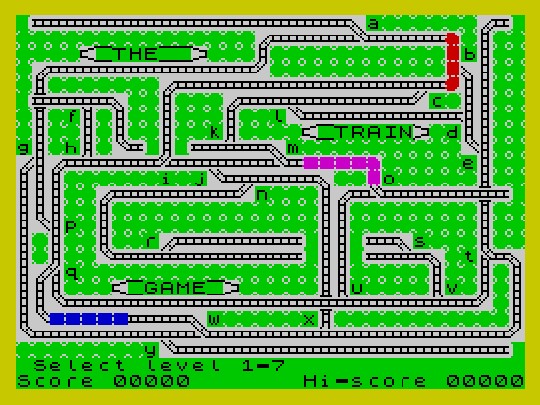
The seeming dead ends are
actually tunnels – the one at top right loops to the one at middle
right, for example.
But this feature isn't here to go on
and on about how great The Train Game is (which is to say,
amazingly great), but rather to identify its connection to The
Typing Of The Dead, and your correspondent is sure that the
intelligent, alert readers of Retro Gamer have spotted at least the
obvious half of it already. Off the top of your reporter's
knowledge-filled head, these are the only two videogames ever
created (with the exception of later spinoffs like Typing Space
Harrier, and obviously discounting specifically educational
software) in which the primary gameplay skill is intimate
familiarity with the layout of the QWERTY keyboard. But there's a
bit more to it than that.
Both The Train Game and The Typing Of The Dead, in essence, are not
only about typing skill, but about threat management. Most of the
time, in either game, you'll have two or three pressing problems to
deal with at any given moment, and not only do you have to deal with
them all, you'll have to near-instantly assess their relative
urgency and deal with them all in the right order. In both
games, in fact, it's very frequently necessary to solve one problem
purely to be able to even start tackling the second at all.
(In TTOTD you have to completely finish typing one zombie's phrase
before you can engage the next one, or fight off the projectiles the
first one's thrown at you. Similarly, in The Train Game you'll often
have to route one train through a section of track as another one
bears down unstoppably on the same stretch from the opposite
direction. In either case, prioritise your actions wrongly and
you're buggered.)
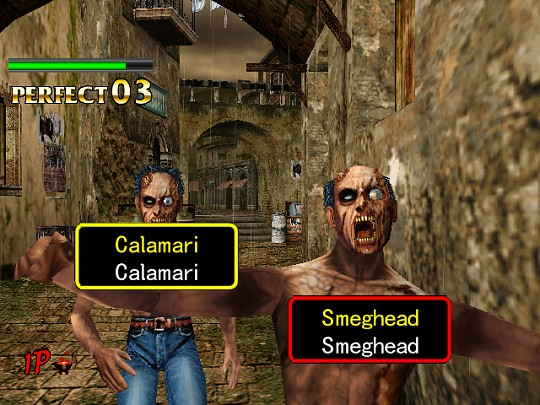
Spook! 'Calamari Smeghead'
was my name when I was in a punk band in the late 80s.
The truth of the matter is
that if you strip away all the surface irrelevance, TTOTD and TTG
are basically the same game. As befits their respective heritages,
The Typing Of The Dead is a little less cerebral and more manic, but
at the higher difficulty levels The Train Game is if anything the
faster-paced of the two, as well as harder and more relentless. Take
on Track B at level 7 and you'll be doing well to last much over a
minute. TTG actually inspired at least one more-obvious clone, in
the form of German developer Kingsoft's superficially very similar
Locomotion for the Amiga in 1992 (a fine game in its own right,
which replaced the typing-based point-switching with
mouse-controlled cursor-pointing), but it's only The Typing Of The
Dead that plays the same way as its parent.
Only one of them's funny, though.
|
TARG-GET MEN
Sometimes
the connections between games are a lot easier to spot,
of course. As long as you're old enough, anyway. You've
got to be a pretty long-in-the-tooth videogamer to
remember Exidy's primitive 1980 coin-op Targ, but if you
are then it's not hard to pick its grandson out of the
ranks of today's high-resolution superstars.
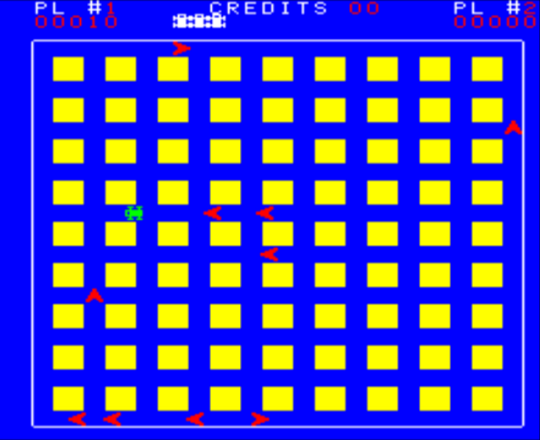
You have to
start a level very poorly to find yourself in this much
trouble.
Targ is one
of the simplest videogames ever released. Despite being
set in the picturesque-sounding metropolis of "Crystal
City", every level is an identical grid of yellow blocks
inhabited by 10 red "ramships", whose name gives away
their only attacking capability - crashing into you. You
steer your chunky green "Wummel" truck around, shooting
the ramships and the Spectar Smuggler, a blue cruiser
worth up to 90 times as many points as the ramships but
which only shows up occasionally from a random block of
the city.
Just a few seconds playing Targ, watching the initial
wave of arrowhead-shaped ramships sweep down the screen
in a perfect line, will immediately trigger a sense of
familiarity and recognition in all but the most
unobservant of modern gamers. Can you guess what it is
yet?
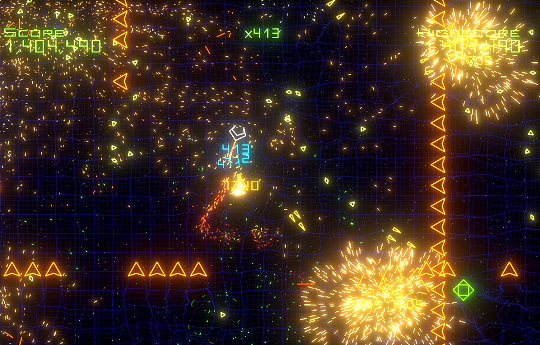
Trivia fact!
This screenshot shows the PGR4 version of Waves, not the
Geometry Wars 2 one.
Geometry
Wars: Waves doesn't just share a superficial enemy
shape, axes of movement and mode of attack with Targ,
though those are the most instantly-obvious
similarities. In both games, shooting the main enemies
isn't your real source of points - it's just something
you do to stay alive while you wait for the opportunity
to nail the big rewards, whether that's a Spectar
Smuggler or a juicy clump of score-multiplying Geoms.
(In another little piece of borrowed DNA, Targ
multiplies the scores for ramships as you go on too.)
But the
main common facet of the two games is the extraordinary
addictiveness created by the bone-simple gameplay, in
which despite the almost total absence of intelligence
or sophistication in your enemies (Targ's ramships are
just about smart enough to get out of the way of
a bullet if they see it coming at them from a long way
off, while Waves' denizens aren't even as bright as
that), a single game lasting over a minute is
an epic feat of skill. Since it's hard to accept being
done for by such dimwitted opponents, off you go again
and the next thing you know four hours have passed.
(Waves in particular is a brutal time thief.)
If you
doubt me, fire up Targ in MAME and see if you can beat
the default highscore, which is just 10,000. (Reaching
the fourth screen will just about guarantee that many
points, and the difficulty increases only by a tiny
fraction along the way.) You're going to be there for a
while.
|
CASE FILE #3 – THE PIT
The last game we’re going to look at is
a much-overlooked classic, but one that alert viewers will recall
already having been touched on passingly in the pages of previous
issues of Retro Gamer - Centuri's 1982 coin-op The Pit, the game
that gave birth to Boulder Dash.
(It gave birth to Boulder Dash at the scandalously young age of
two, in fact - the latter game having been released in 1984 -
but let's just skip over that alarming and disturbing paedo-fact for
the sake of decency and move swiftly on.)
Boulder Dash is most commonly associated with the two classic
earth-shifting arcade games Dig Dug and Mr Do, but beyond the
underground setting it has almost nothing in common with either
title. Dig Dug and Mr Do are both fundamentally about battling your
enemies, not negotiating your environment. There are no obstacles in
your way, and the rocks/apples which can fall down the screen are
really there as weapons rather than dangers.
The Pit is different, though. While there are enemy
characters chasing your diamond-hunting miner, they're pretty much
only a distraction. It's perfectly simple for even a
slightly-skilled player to conduct the first few seconds of any
level in such a way (illustrated in the screenshot below) that the
claw-wielding baddies are confined to a small space at the upper
centre of the pit, completely blocked off from anywhere the player
needs to go.
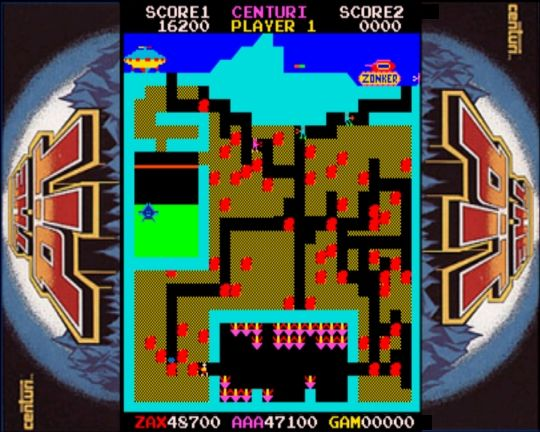
Here you’ve managed to
block off all the pink and blue enemy robots’ paths with rocks (seen
just to the left
and to the right of the central crossroads), and since they lack any
digging ability they can’t get to you at all.
Your problem in The Pit is
- like Boulder Dash - chiefly to navigate your way safely around
each level in order to collect some diamonds and then get out of the
exit without having a rock fall on your head. (Also like Boulder
Dash, you don't actually have to collect all of a level's diamonds,
but there are temptingly large bonuses for picking up more than the
minimum.) There are walls, bottlenecks, rooms and environmental
hazards, as well as the liberal scattering of rocks that constitutes
the core gameplay element of both titles.
The similarities don't end there, though. For one thing, your miner
doesn't just plough through earth like in Dig Dug and Mr Do. To make
a tunnel, he blasts away a square of space with his, um, anti-dirt
laser, then pauses for a moment before moving into the gap. (This is
very much a character-block-centred game, which makes it all the
weirder that nobody ever converted it to the Speccy. There were
unofficial ports to the VIC-20 and the C64 though, one of the very
few advantages of the CBM machines over the rubber-keyed wonder.)
The skilled player, however, can use this behaviour to take out an
adjacent
square of earth and then quickly move off in a different direction,
in a manner very akin to the Boulder Dash trick of holding down the
fire button to dig/push/pick up something without moving into its
space. In both games, it's a subtle play mechanic that separates the
novice player from the expert.
And lastly, there's the behaviour of the enemy characters. The
little grab-robots don't actually chase you - like all the moving
enemies in Boulder Dash, they follow fixed movement patterns (if
there's an empty space below, go down, if you can't go down then try
to go left, etc)
and only kill you if you get very close to them, at which point they
leap on you and smush you. And as in Boulder Dash, they can only
move in existing tunnels - they can't dig their own. And yet despite
all this - their slow pace, limited abilities, lack of weaponry,
rigidly-dictated movement and non-vindictive nature, you'll really
come to hate the little bastards. (Maybe it's the way there's a brief
but violent struggle when one attacks you, a bit like in Maziacs but
with the crucial difference that you never ever win. It looks like a
brutal way to die.)
If you want to see where it all ultimately led, either check out the
superb Boulder Dash Xmas 2002 Edition, which is the finest BD game
ever (playable for free online, with a full-featured downloadable
version for about 11 quid), or Gran Turismo 5. See you next time, viewers!
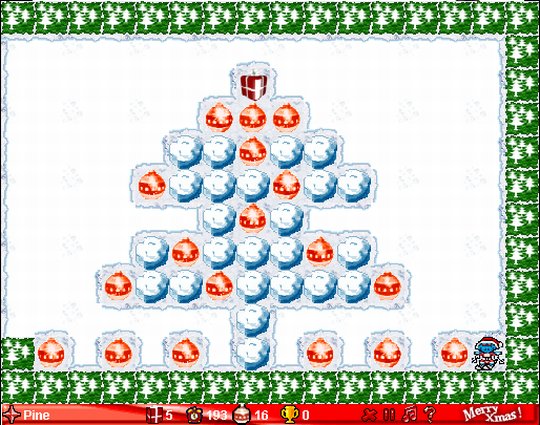
This innocent first level
might not look exciting, but Boulder Dash Xmas 2002 Edition is the
finest collection
of brilliantly fiendish BD levels since the series was invented. You
can play the full game for free
here.
|
HANG ON A MINUTE -
WHAT?
(“The Pit is basically
the same game as Gran Turismo 5? WTF?" – Bemused reader, Essex)
Ah yes. The thing is, like many parents in today’s
shamefully immoral society, The Pit had more than one
offspring to more than one partner. Y’see, the use of
the phrase “any level” back in the opening paragraphs of
the Pit’s entry is a slight misnomer. The game only has
two different screens - which are actually the same one
except for rock placement - which alternate at
ever-increasing pace until everything happens at
blinding speed and becomes as much a test of memory as
reflex. The enemies are largely incidental, pursuing
their own path regardless of what you do and only
causing you trouble if you actively collide with them.
Sound
familiar at all?
The Pit is all about racing the same circular courses
(you start and finish in the same spot) over and over,
doing “laps” around them until you find the line that’s
both fastest and avoids the pre-programmed enemy AI. As
it goes on, you know exactly what to do and when, but
sometimes your fingers just aren’t quick enough or
co-ordinated enough to perform the actions your brain’s
telling them to. Sometimes you panic and crash into an
enemy because you’re short of time. Sometimes one
mistake will force you to significantly amend your route
and improvise a new ad hoc one, as it brings you
perilously close to opponents you should have avoided.
It doesn’t look like a driving game, but in every
meaningful sense that’s exactly what it is, and in
particular highly rigid and technical ones like the GT
series.
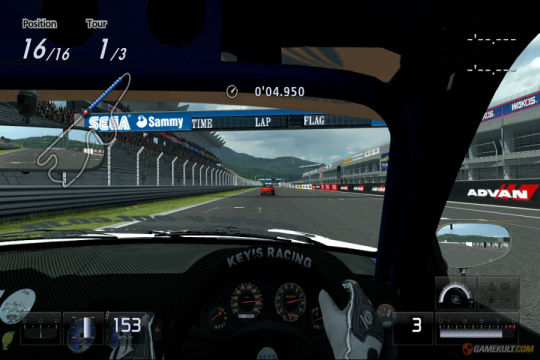
I don’t know if
I can stay awake long enough to write a caption for this
pictZZZZZZ.
Videogamers have a lot of
trouble with this concept, but in fact it’s really what
this entire feature is about. No matter what the
onscreen graphics depict, the simple mechanical fact of
playing ANY videogame is that you’re pressing left and
right and fire to move blobs of coloured light around a
screen. It doesn’t matter if the game world nominally
exists in two dimensions or three, whether you’re
viewing it from above or to the side or out of your
character’s “eyes” or whatever – you’re still just
pressing left and right and fire on the joypad to move
the lights around. To an observer who’s standing behind
your telly, you appear to be doing the exact same things
no matter whether you’re playing Tetris, Pac-Man, Call
Of Duty 4 or Broken Sword: Shadow Of The Templars
Director's Cut, and that’s because you are.
Fundamental gameplay concepts have nothing to do with
either graphical style or game setting. It’s hard to
imagine two more diverse things than, say, the story of
Noah preserving the world’s animal species in the Ark
and a heroic soldier invading a Nazi fortress to kill a
massive cyborg Hitler. Yet the exact same game engine
and gameplay concepts were used for both Super Noah’s
Ark and Wolfenstein 3D on the SNES. They’re basically
the same game dressed in different clothes, and it
shouldn’t take a big mental leap to grasp that that
simple fact – which is pretty obvious in the case of
Super Noah's Ark
and Wolfenstein - also extends to relationships between games
that appear to be a lot less similar to each other.
Don’t let your eyes fool you, chums. If you ever want to
truly understand games, be they retro or ultra-modern,
you really need to get your heads round that idea.
Also, of course, The Pit is a lot more fun than
Gran Turismo.
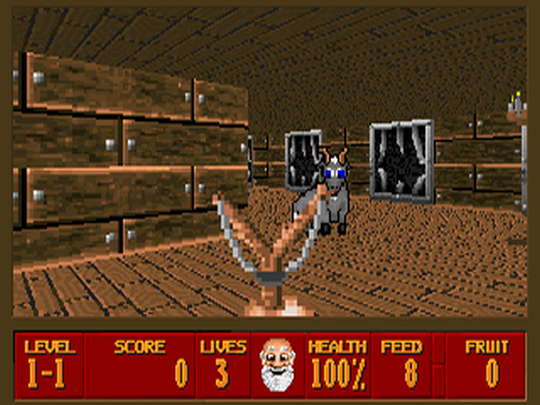
Feeding animals
on a boat: a lot like shooting Nazis in a castle.
|
|

